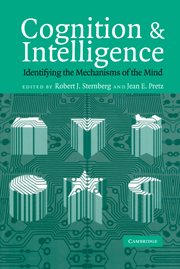Book contents
- Frontmatter
- Contents
- Preface
- 1 Information Processing and Intelligence: Where We Are and Where We Are Going
- 2 Mental Chronometry and the Unification of Differential Psychology
- 3 Reductionism versus Charting: Ways of Examining the Role of Lower-Order Cognitive Processes in Intelligence
- 4 Basic Information Processing and the Psychophysiology of Intelligence
- 5 The Neural Bases of Intelligence: A Perspective Based on Functional Neuroimaging
- 6 The Role of Working Memory in Higher-Level Cognition: Domain-Specific versus Domain-General Perspectives
- 7 Higher-Order Cognition and Intelligence
- 8 Ability Determinants of Individual Differences in Skilled Performance
- 9 Complex Problem Solving and Intelligence: Empirical Relation and Causal Direction
- 10 Intelligence as Smart Heuristics
- 11 The Role of Transferable Knowledge in Intelligence
- 12 Reasoning Abilities
- 13 Measuring Human Intelligence with Artificial Intelligence: Adaptive Item Generation
- 14 Marrying Intelligence and Cognition: A Developmental View
- 15 From Description to Explanation in Cognitive Aging
- 16 Unifying the Field: Cognition and Intelligence
- Author Index
- Subject Index
- References
8 - Ability Determinants of Individual Differences in Skilled Performance
Published online by Cambridge University Press: 23 November 2009
- Frontmatter
- Contents
- Preface
- 1 Information Processing and Intelligence: Where We Are and Where We Are Going
- 2 Mental Chronometry and the Unification of Differential Psychology
- 3 Reductionism versus Charting: Ways of Examining the Role of Lower-Order Cognitive Processes in Intelligence
- 4 Basic Information Processing and the Psychophysiology of Intelligence
- 5 The Neural Bases of Intelligence: A Perspective Based on Functional Neuroimaging
- 6 The Role of Working Memory in Higher-Level Cognition: Domain-Specific versus Domain-General Perspectives
- 7 Higher-Order Cognition and Intelligence
- 8 Ability Determinants of Individual Differences in Skilled Performance
- 9 Complex Problem Solving and Intelligence: Empirical Relation and Causal Direction
- 10 Intelligence as Smart Heuristics
- 11 The Role of Transferable Knowledge in Intelligence
- 12 Reasoning Abilities
- 13 Measuring Human Intelligence with Artificial Intelligence: Adaptive Item Generation
- 14 Marrying Intelligence and Cognition: A Developmental View
- 15 From Description to Explanation in Cognitive Aging
- 16 Unifying the Field: Cognition and Intelligence
- Author Index
- Subject Index
- References
Summary
At the most fundamental level, the relationship between intelligence and learning is close and convincing. Indeed, the modern era of intelligence assessment is identified with the critical success of Binet and Simon (1905) in their development of a set of scales that provided valid predictions of school success. These scales, or similar assessments inspired by this approach (such as the Wechsler Intelligence Scale for Children; Wechsler, 1949), continue to represent the best predictors of school success. School success, at least for children and adolescents, is considered by many to be the indicator of learning achievement. While this analysis works quite well for global measures of learning, there is far less utility of omnibus IQ-type measures for predicting individual differences in narrower domains of learning. If we want to predict which students will excel in learning a musical instrument, mastering power tools, or becoming adept at a particular sport, or even which students will become the fastest typists, the relationship between intelligence and learning appears to be much more complicated.
Part of the reason why IQ-type measures are less valid for predicting individual differences in skilled performance has to do with the relative “bandwidth” of the assessment instrument and the breadth of the criterion, or what has been referred to as a lack of Brunswik symmetry (Wittmann & Süß, 1999). That is, IQ tests have high bandwidth — they are typically constructed from as many as a dozen different scales (e.g., memory, reasoning, vocabulary, math, etc.).
- Type
- Chapter
- Information
- Cognition and IntelligenceIdentifying the Mechanisms of the Mind, pp. 142 - 159Publisher: Cambridge University PressPrint publication year: 2004
References
- 3
- Cited by



